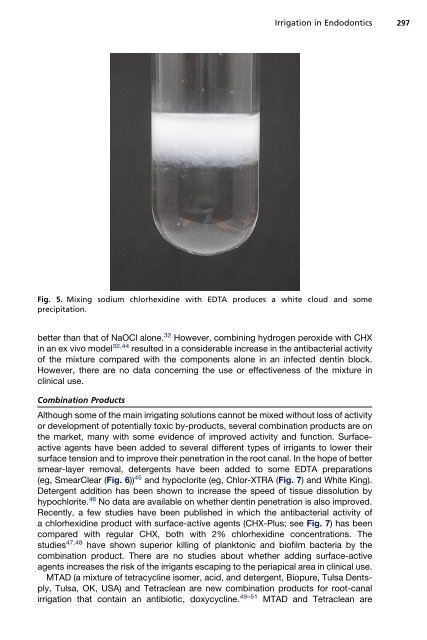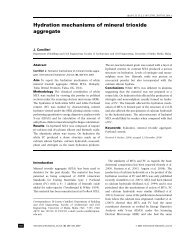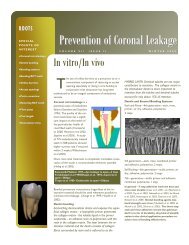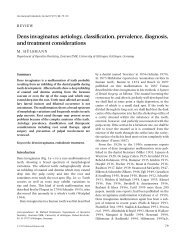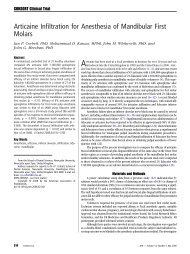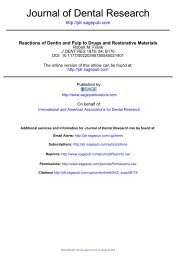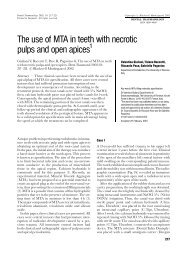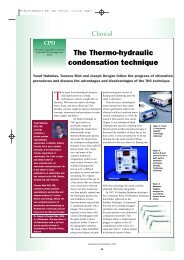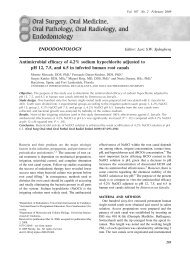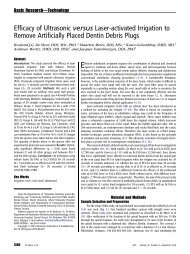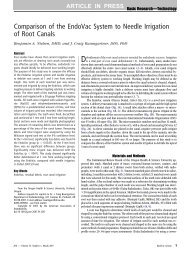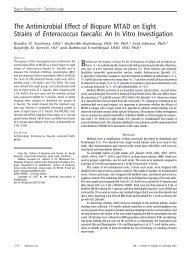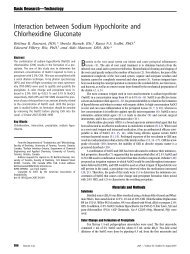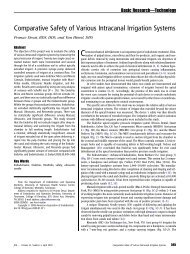Irrigation in Endodontics - The Endoexperience
Irrigation in Endodontics - The Endoexperience
Irrigation in Endodontics - The Endoexperience
You also want an ePaper? Increase the reach of your titles
YUMPU automatically turns print PDFs into web optimized ePapers that Google loves.
<strong>Irrigation</strong> <strong>in</strong> <strong>Endodontics</strong> 297<br />
Fig. 5. Mix<strong>in</strong>g sodium chlorhexid<strong>in</strong>e with EDTA produces a white cloud and some<br />
precipitation.<br />
better than that of NaOCl alone. 32 However, comb<strong>in</strong><strong>in</strong>g hydrogen peroxide with CHX<br />
<strong>in</strong> an ex vivo model 32,44 resulted <strong>in</strong> a considerable <strong>in</strong>crease <strong>in</strong> the antibacterial activity<br />
of the mixture compared with the components alone <strong>in</strong> an <strong>in</strong>fected dent<strong>in</strong> block.<br />
However, there are no data concern<strong>in</strong>g the use or effectiveness of the mixture <strong>in</strong><br />
cl<strong>in</strong>ical use.<br />
Comb<strong>in</strong>ation Products<br />
Although some of the ma<strong>in</strong> irrigat<strong>in</strong>g solutions cannot be mixed without loss of activity<br />
or development of potentially toxic by-products, several comb<strong>in</strong>ation products are on<br />
the market, many with some evidence of improved activity and function. Surfaceactive<br />
agents have been added to several different types of irrigants to lower their<br />
surface tension and to improve their penetration <strong>in</strong> the root canal. In the hope of better<br />
smear-layer removal, detergents have been added to some EDTA preparations<br />
(eg, SmearClear (Fig. 6)) 45 and hypoclorite (eg, Chlor-XTRA (Fig. 7) and White K<strong>in</strong>g).<br />
Detergent addition has been shown to <strong>in</strong>crease the speed of tissue dissolution by<br />
hypochlorite. 46 No data are available on whether dent<strong>in</strong> penetration is also improved.<br />
Recently, a few studies have been published <strong>in</strong> which the antibacterial activity of<br />
a chlorhexid<strong>in</strong>e product with surface-active agents (CHX-Plus; see Fig. 7) has been<br />
compared with regular CHX, both with 2% chlorhexid<strong>in</strong>e concentrations. <strong>The</strong><br />
studies47,48 have shown superior kill<strong>in</strong>g of planktonic and biofilm bacteria by the<br />
comb<strong>in</strong>ation product. <strong>The</strong>re are no studies about whether add<strong>in</strong>g surface-active<br />
agents <strong>in</strong>creases the risk of the irrigants escap<strong>in</strong>g to the periapical area <strong>in</strong> cl<strong>in</strong>ical use.<br />
MTAD (a mixture of tetracycl<strong>in</strong>e isomer, acid, and detergent, Biopure, Tulsa Dentsply,<br />
Tulsa, OK, USA) and Tetraclean are new comb<strong>in</strong>ation products for root-canal<br />
irrigation that conta<strong>in</strong> an antibiotic, doxycycl<strong>in</strong>e. 49–51 MTAD and Tetraclean are


